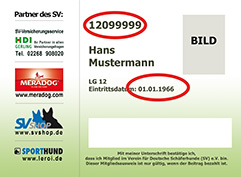Dr. Tellhelm, how do you rate the efficiency of the HD/ED procedure in the SV?
Through the phenotypical breeding selection against HD effected already for many years we have succeeded in immensely reducing the frequency of HD in the population. Nevertheless, one has to be clear about two things: One, the strictly phenotypical selection, i. e. the selection of breeding partners according to their own HD evaluation, has limitations, as this evaluation is not solely influenced by genetics. Therefore, the HD evaluation does not reliably indicate the HD heredity. Two, we can only make statements about the dogs of which X-rays were sent in for evaluation. Here, unfortunately, a strict preselection is taking place, so that the frequency of HD In the total population of German Shepherds is presumably significantly higher than the official statistic shows. This communication gap regarding the actual existence of HD in the population of German Shepherds also obstructs the breeding measures.
The fewer dogs with distinctive HD exist in the population, the slower the breeding progress is if the breeding partners are put together solely regarding HD evaluations, i. e. when it is selected solely phenotypically. Therefore, the SV has decided to introduce the estimation of breeding values for HD in 1999. As the estimation of breeding values also takes into consideration the information of relatives and corrects this information regarding environmental influences, “discounting” these environmental influences, breeding values give more information about the genetic endowments for HD of a dog. Based on HD breeding values, the pairs can be planned better than on the basis of the HD evaluations of the parents.
However, the improvement of the HD situation was less clear than expected. One reason for this is surely the breeders holding on to the phenotype selection and a correspondingly low use of the HD breeding values for selection purposes. More essential is probably the already mentioned fact that only a part of all dogs are X-rayed and a big part of the dogs with unfortunate HD results is not brought in for evaluation. If for the breeding value estimation there is only or mainly advantageous information, genetic differences can hardly be detected and not with the necessary reliability. If more HD information was put at disposal, we would have a higher breeding value security and could select more efficiently against HD.
The course of the HD frequency since 1968 was shown very impressively in graphics by the association’s breeding warden, Mr. Quoll, in the SV magazine of September 2013.






